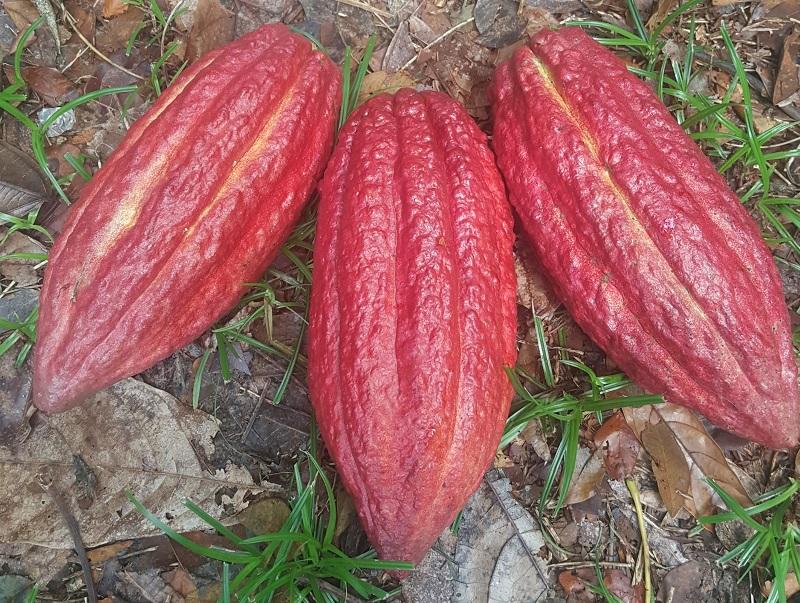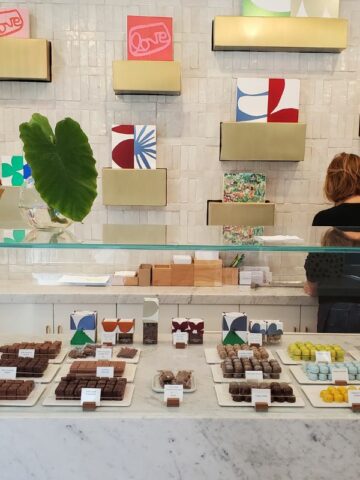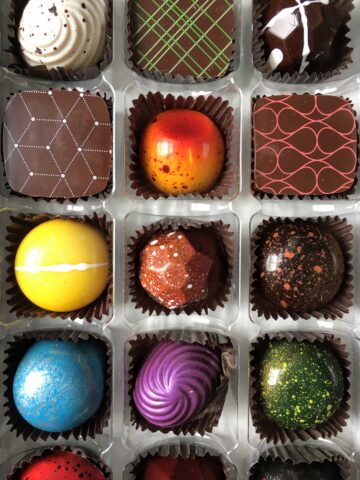Fiji is not a commonly-referenced cacao origin, but the island chain produces hundreds of tons of cacao each year. On the global scale, this amount barely registers but for the fact that it shows rising production. Yet the vast majority of the chocolate consumed on the islands is imported, and largely bears rather distinctive purple packaging.
The tide is beginning to shift, however, as over a hundred years of history and a couple decades of tireless work slowly change the paradigm. One couple's effort to find a better market for local farmers has become the choice which transformed the Fijian cacao industry. But the growth hasn't stopped there.

Jump To
A Taste of Fijian History
Before we can get too far into Fiji's relationship with chocolate, I think it's important to understand some of the country's history. Fiji is a small nation in the South Pacific, with about 900,000 citizens and a few hundred islands.
Most people who've heard of Fiji picture it as one big tropical paradise, or perhaps more commonly, their minds wander towards rugby players and FIJI Water®. But Fiji is so much more than sparkling blue water and white sand beaches.
Fiji's been inhabited for thousands of years, by Austronesian and Melanesian peoples indigenous to the region. In the early 1800’s, Europeans established trade relationships with native Fijians, with whom they first came into contact some decades before.
But by the late 1800’s, surprise surprise, the British had claimed Fiji as a colony. Shortly thereafter, they began trafficking in people from their already-established colony of India.

So many Indians were taken to Fiji that the country’s population is now approximately one-third Indo-Fijian. Many of these 4th- and 5th-generation Indians still speak Hindi and practice Hinduism or Islam. Indigenous culture is not lost, however.
Melanesian tribal patterns can still be spotted across the country, in clothing, souvenirs, and even tattoos. I found Fijian people to be quick to smile, and incredibly honest.
Taro, cassava, and seafood are the basis for many traditional dishes. But people and a thirst for trade were, of course, not the only thing that the British brought to the South Pacific. Around the same time, the Brits also brought cacao.
How Fijian Cacao Has Come to Be
According to local chocolate maker Tomo Zukoshi, in the 1880's, The Royal Botanical Garden of England sent cacao to Fiji, which by then had been claimed as a British colony. Due to increased taxes on goods from the Caribbean, seeking non-Caribbean sources for cacao had become a high priority for the Brits. So after almost a year's journey through South Asia and Oceania, cacao trees finally arrived on the islands of Fiji.
Over the next few decades, the cacao was naturally propagated by local people and animals, but interest slowly petered out. But a light was once again shone upon the cacao at some point in the 1980's, with the government buying some cacao in an effort to promote its cultivation.
Finally, it was again remembered in the mid-2000's, with Tomo's efforts to buy from local farmers near the city of SavuSavu. Now 15 years later, and Tomo is still buying from those same farmers, along with dozens more across the islands.
In those intermittent years, other commercial cacao projects have started in the cacao sector, including Cacao Fiji in the northern part of Vanua Levu Island. With the support of the government, the small team at Cacao Fiji are working to convince local farmers to keep their existing cocoa rather than replace it with a competing crop, like kava.
Along with their own harvest, the team buys wet cacao beans from many farmers in the region. Much of that harvest gets sent to Nadi, where the owners of the Cacao Fiji turn it into chocolate.
Smaller farm projects have also started up, with farmers taking the initiative to not only grow their own cacao, but process it well and export it or turn it into chocolate themselves. This is still a relatively small movement, but it's one which may have an important role to play in the future of Fijian chocolate.

Craft Chocolate in Fiji
Right now, there are two main Fijian chocolate brands: Vanua Chocolate and Fijiana Cacao. The latter is owned & operated by Tomo and Harumi Zukoshi, and was originally made famous under the brand Adi Chocolate. But some younger companies have entered the scene over the years, the most visible of which being Vanua Chocolate.
Zain and Arif Khan are the co-founders of Vanua Chocolate. They also own Cacao Fiji, the cacao processor in northern Vanua Levu. Zain moved to the city of Nadi several years ago with her husband, who grew up on Fiji. They started Cacao Fiji in 2015, and Vanua Chocolate just 3 years later, a full decade after Tomo began Adi Chocolate.
The country still imports most of the 500MT of chocolate consumed annually on Fiji, much of it from the Cadbury collection of purple chocolates. Many Fijians are starting to indulge in locally-made chocolate, but unfortunately, for most Fijians the $15-16FJD bars (~$8USD) are out of their price range.
Therefore, over the last fifteen years, Fiji's chocolate consumption has largely fallen into the hands of tourists, creating a dependence from which it's difficult to break free.
Tourism's Role in Fijian Chocolate
The importance of tourism to Fiji’s economy cannot be understated. According to government data from 2019, visitors arriving for a vacation spend more on average than any other visitor, and per trip they spend thousands of Fijian dollars per person. Considering the volume of annual visitors to Fiji, this amounts to a huge chunk of the country's GDP. For local businesses making a 100% Fijian product, like a chocolate made with local cacao and sugar, this presents the perfect opportunity.
Unfortunately, the majority of tourism dollars arrive to just one region of the main island, Viti Levu. Right around the international hub of Nadi (pronounced "Nahn-dee") are the two artisanal Fijian chocolate companies mentioned above. For their part, Fijiana Cacao has come to be out of the founding brand of Adi Chocolate, a direct-trade chooclate company started by Tomo and Harumi Zukoshi in the back of their restaurant in 2005.
Tomo estimates that about one-third of all visitors to Fiji now try their chocolate before leaving the islands; much of his business is dealing directly with resorts. Cacao Fiji, which buys cacao from across the island Vanua Levu, now exports about 90% of the cacao they process. The remaining 10% go to their chocolate brand, Vanua Chocolate, which sells largely to tourist-oriented retail shops and resorts.
Coronavirus has also crushed the chocolate industry in Fiji. Even though there are only 18 reported cases of the virus on Fiji, tourism has come to a screeching halt. Tens of thousands of Fijians who are dependent upon jobs in the sector are scrambling for an income, and this includes local cacao farmers and chocolate makers.
The Future of Chocolate in Fiji
In light of the current pandemic, the future of Fijian chocolate is more uncertain than ever. With much of the consumption dependent upon consistent tourism, the industry is under strong threat from competing crops, such as kava. If you haven’t heard of kava, it’s a plant native to the South Pacific and related to the pepper family. It has calming & muscle relaxing effects, and has been used as a ceremonial beverage in the region for centuries.
Right now, prices are high, so many farmers are switching to growing kava, including those who currently grow cocoa. But there are some signs of hope on the islands, in the form of small private farms. One such farm, Olsen farm, represents perhaps the third stage of Fiji’s chocolate industry. The owners of the farm have been working to bring their farm's cacao trees back into production, and then process the cacao themselves.

Similar to what's been happening on Hawaii, some Fijian farmers may be going into the chocolate business. But even with smaller operations across the country, Fijian cacao’s future isn’t written in stone. During this pandemic, Tomo Zikoshi is still buying cacao from farmers across the islands. Some of these farmers he’s known for over a decade, and he’s maintained these relationships even when it doesn’t make any financial sense, like right now.
That kind of dedication doesn't just disappear. I can’t imagine what the people of Fiji are feeling right now. My heart goes out to them, and everyone else whose lives have been upended, and even lost in the face of the virus. In such unprecedented times, I’m not sure what Fiji’s cacao industry will look like a year from now. But we all hope it's still there.

















Comments
No Comments